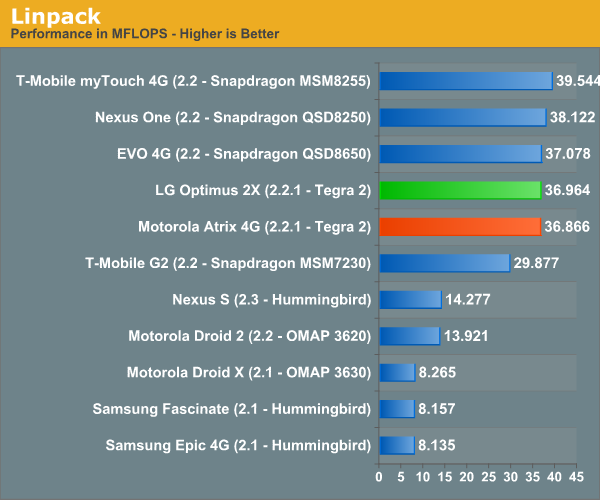The Motorola Atrix 4G Preview
by Anand Lal Shimpi on February 13, 2011 3:18 AM ESTPerformance
Architecturally there's no difference between the AP20H in the Optimus 2X and the Atrix 4G. You still have the same two ARM Cortex A9 cores running at 1GHz.
In our Optimus 2X review I talked about PoP (Package on Package) stacking used by SoC vendors to integrate DRAM without requiring more board real estate. The beauty of PoP stacking is that you can integrate the DRAM after both it and the SoC have already been manufactured. It's a package bonding exercise, not a fabrication one.

Package on Package (DRAM on top, SoC on bottom)—source: statschippack.com
The result is that making custom combinations of SoC and DRAM isn't as tall of an order as making a custom SoC with three CPU cores or more cache. The latter can only be done with a tremendous investment in capital.
For the Atrix 4G, Motorola wanted a Tegra 2 paired with a 1GB LPDDR2 DRAM. Most SoCs these days only incorporate 512MB.
The performance benefit of a 1GB DRAM in any individual benchmark is negligible. In fact, normal smartphone usage (even with multitasking) doesn't require more than 512MB of system memory at this point. You can get close, but it's pretty challenging to go over given the requirements of Android 2.2.1 and popular apps today. As a result you won't see the 1GB of memory give Motorola an edge in any benchmarks.

It's only in the heaviest multitasking scenarios or when using Motorola's webtop app that the extra memory comes in handy. This is something I'm going to be investigating more over the coming weeks. I haven't had enough time to come up with any interesting usage models that are benchmarkable between the Optimus 2X and Atrix 4G to quantify the difference in performance for smartphone users.

Despite the extra DRAM, Motorola is actually at a disadvantage in many benchmarks. The motoBlur UI enhancements and skinning do impact performance. Even after using a task killer to stop all non-system processes, some components of motoBlur will automatically restart. Thankfully two Cortex A9s are enough to hide this from being a problem in the day to day usage of the phone, but it does mean that the Atrix 4G sometimes benchmarks slightly lower than the Optimus 2X. It's like bloatware that ships on some OEM PCs, just much more tightly integrated and not as easy to get rid of. I hesitate to make that comparison though because, like I said, the performance impact is minimal.

Real World Performance Impressions
The Optimus 2X went straight to Brian, so I didn't get a chance to play with it running the latest software build. When I first laid hands on LG's Tegra 2 phone a few months ago it was running a much, much earlier software build and real world performance wasn't representative of what we have today. To make a long story short, I'd never spent any quality time with a Cortex A9 based smartphone running a mature build of Android.
Instead I had to listen to Brian talk about how fast the Optimus 2X was, and how it would be his favorite Android phone if the review OS build was just more stable. The only Android phones I have in my office are a Nexus One, an Epic 4G and a Streak. I longed for something faster.
After using the Atrix 4G as my only smartphone I must say, I completely agree with Brian's assessment. The dual Cortex A9s in NVIDIA's Tegra 2 make Android so much better. Even though the Atrix 4G is only running Froyo (2.2.1) it felt like the fastest Android phone I'd ever used, including my brief stint with the Nexus S.
You see the Nexus S's partially GPU accelerated build of Android (Gingerbread) makes scrolling through your list of apps buttery smooth. Even the Atrix 4G lacks that. Every now and then you get a stutter or hiccup, but it's usually pretty good.
Where the Nexus S falls short however is in actual application response time and in performance when switching between apps. Trips back to the home screen, launching new apps and even interacting with apps all feels quicker on the Atrix 4G than anything sans-Tegra 2.
We tend to get spoiled by super fast hardware given the nature of our work. As a result, when things don't perform up to par we're a lot more sensitive. If you find yourself in the same boat, then (at least today) Tegra 2 may be the only way to scratch that itch.
By no means is this SoC perfect. A pair of Cortex A9s is still pretty slow in our universe, but within the snowglobe of SoCs that currently run Android it's a noticeable improvement. I suspect this is how things will go for the next few years. I'll likely have the same feelings after using my first Cortex A15 based phone, and whatever comes after that. It's the beauty of the golden age of ILP: performance gains are easy to come by and are very noticeable.










41 Comments
View All Comments
tipoo - Saturday, October 8, 2011 - link
This was a preview, is a review still coming?